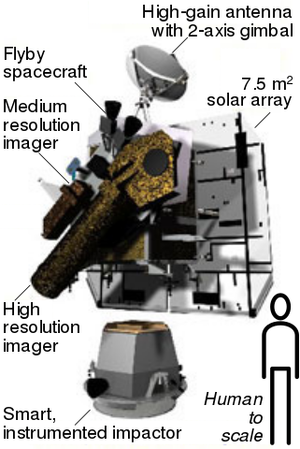Deep Impact (spacecraft) (nonfiction): Difference between revisions
(Created page with "thumb|Diagram of the ''Deep Impact'' spacecraft.'''''Deep Impact''''' was a NASA space probe launched from Cape Canaveral Air Force Station at 18:47 U...") |
No edit summary |
||
| Line 15: | Line 15: | ||
== Fiction cross-reference == | == Fiction cross-reference == | ||
* [[Crimes against astronomical constants]] | |||
* [[Gnomon algorithm]] | |||
* [[Gnomon Chronicles]] | |||
== Nonfiction cross-reference == | == Nonfiction cross-reference == | ||
| Line 23: | Line 27: | ||
* [https://en.wikipedia.org/wiki/Deep_Impact_(spacecraft) Deep Impact (spacecraft)] @ Wikipedia | * [https://en.wikipedia.org/wiki/Deep_Impact_(spacecraft) Deep Impact (spacecraft)] @ Wikipedia | ||
[[Category:Nonfiction (nonfiction)]] | [[Category:Nonfiction (nonfiction)]] | ||
[[Category:Spacecraft (nonfiction)]] | [[Category:Spacecraft (nonfiction)]] | ||
Latest revision as of 12:52, 8 September 2018
Deep Impact was a NASA space probe launched from Cape Canaveral Air Force Station at 18:47 UTC on January 12, 2005.
It was designed to study the interior composition of the comet Tempel 1 (9P/Tempel), by releasing an impactor into the comet.
At 05:52 UTC on July 4, 2005, the impactor successfully collided with the comet's nucleus. The impact excavated debris from the interior of the nucleus, forming an impact crater.
Photographs taken by the spacecraft showed the comet to be more dusty and less icy than had been expected. The impact generated an unexpectedly large and bright dust cloud, obscuring the view of the impact crater.
Upon the completion of its primary mission, proposals were made to further utilize the spacecraft. Consequently, Deep Impact flew by Earth on December 31, 2007 on its way to an extended mission, designated EPOXI, with a dual purpose to study extrasolar planets and comet Hartley 2 (103P/Hartley).
In the News
Fiction cross-reference
Nonfiction cross-reference
External links:
- Deep Impact (spacecraft) @ Wikipedia
